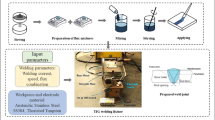Abstract
Five single oxide fluxes—Cu2O, NiO, SiO2, CaO, and Al2O3—were used to investigate the effect of active flux on the depth/width ratio in SUS304 stainless steel. The flux quantity, stability, and particlesize effect on the weld-pool shape and oxygen content in the weld after welding was studied systematically. The results showed that the weld depth/width ratio initially increased, followed by a decrease with the increasing flux quantity of the Cu2O, NiO, and SiO2 fluxes. The depth/width ratio is not sensitive to the CaO flux when the quantity is over 80×10−5 mol on the 5×0.1×50 mm slot. The Al2O3 flux has no effect on the penetration. The oxygen content dissolved in the weld plays an important role in altering the liquid-pool surface-tension gradient and the weld penetration. The effective range of oxygen in the weld is between 70 and 300 ppm. A too-high or too-low oxygen content in the weld pool does not increase the depth/width ratio. The decomposition of the flux significantly depends on the flux stability and the particle size. Cu2O has a narrow effective flux-quantity range for the deep penetration, while the Al2O3 flux has no effect. The SiO2 flux with a small particle size (0.8 or 4 µm) is a highly recommended active flux for deep penetration in actual gas tungsten arc welding (GTAW) applications.
Similar content being viewed by others
References
B. Pollard: Welding J., 1988, vol. 67, pp. 202s-213s.
Y. Takeuchi, R. Takagi, and T. Shinoda: Welding J., 1992, vol. 71, pp. 283s-289s.
S. Sire and S. Marya: Proc. 7th Int. Welding Symp. on Today and Tomorrow in Science and Technology of Welding and Joining, Kobe, Japan, Japan Welding Society, Tokyo, Japan, Nov. 20–22, 2001, pp. 113–18.
P.C.J. Anderson and R. Wiktorowicz: Welding Met. Fab., 1996, vol. 64, pp. 108–09.
T. Paskell, C. Lundin, and H. Castner: Welding J., 1997, vol. 76, pp. 57–62.
S. Sire and S. Marya: C.R. Mecanique, 2002, vol. 330, pp. 83–89.
S.M. Gurevich and V.N. Zamkov: Avtom. Svarka., 1966, vol. 12, pp. 13–16.
P.J. Modenesi, E.R. Apolinario, and I.M. Pereira: J. Mater. Proc. Tech-nol., 2000, vol. 99, pp. 260–65.
S. Kou and Y.H. Wang: Welding J., 1986, vol. 65, pp. 63s-70s.
M. Tanaka, T. Shimizu, H. Terasaki, M. Ushio, F. Koshi-ishi, and C.L. Yang: Sci. Technol. Welding Joining, 2000, vol. 5, pp. 397–402.
D.S. Howse and W. Lucas: Sci. Technol. Welding Joining, 2000, vol. 5, pp. 189–93.
H.C. Ludwig: Welding J., 1968, vol. 47, pp. 234s-40s.
Ding Fan, Ruihua Zhang, Yufen Gu, and M. Ushio: Trans. JWRI, 2001, vol. 30, pp. 35–40.
S. Marya and S. Sire: Proc. 7th Int. Weld. Symp. on Today and Tomorrow in Science and Technology of Welding and Joining, Kobe, Japan, Japan Welding Society, Tokyo, Japan, Nov. 20–22, 2001, pp. 107–12.
T. Ohji, A. Miyake, M. Tamura, H. Inoue, and K. Nishiguchi: J. Jpn. Welding Soc., 1990, vol. 8, pp. 54–58.
V.S. Mechev: Welding Int., 1993, vol. 7, pp. 154–56.
C.R. Heiple and J.R. Roper: Welding J., 1982, vol. 61, pp. 97s-102s.
C.R. Heiple, J.R. Roper, R.T. Stagner, and R.J. Aden: Welding J., 1983, vol. 62, pp. 72s-77s.
H. Fujii, N. Sogabe, M. Kamai, and K. Nogi: Proc. 7th Int Welding Symp. on Today and Tomorrow in Science and Technology of Welding and Joining, Kobe, Japan, Japan Welding Society, Tokyo, Japan, Nov. 20–22, 2001, pp. 131–36.
C.R. Heiple and J.R. Roper: Welding J., 1981, vol. 60, pp. 143s-45s.
S. Kou and D.K. Sun: Metall. Trans. A, 1985, vol. 16A, pp. 203–13.
S. Kou and Y.H. Wang: Welding J., 1986, vol. 65, pp. 63s-70s.
C. Limmaneevichitr and S. Kou: Welding J., 2000, vol. 79, pp. 324s-330s.
Y. Wang and H.L. Tsai: Metall. Mater. Trans. B, 2001, vol. 32B, p. 501.
Y. Wang, O. Shi, and H.L. Tsal: Metall. Mater. Trans. B, 2001, vol. 32B, pp. 145–61.
G.M. Oreper, T.W. Eagar, and J. Szekely: Welding J., 1983, vol. 62, pp. 307s-12s.
C.R. Heiple and P. Burgardt: Welding J., 1985, vol. 64, pp. 159s-62s.
J.R. Roper and D.L. Olson: Welding J., 1978, vol. 57, pp. 103s-07s.
H. Tamatsu, K. Nogi, and K. Ogino: J. High. Temp. Soc., 1992, vol. 18, pp. 14–19.
C.H. Wu and D.Q. Hao: Physical Chemistry, 1st ed., Machine Building Press, Beijing, 1988, pp. 138, pp. 287–89.
H.G. Kraus: Weld. J., 1989, vol. 68, pp. 269s-79s.
Author information
Authors and Affiliations
Rights and permissions
About this article
Cite this article
Lu, S., Fujii, H., Sugiyama, H. et al. Mechanism and optimization of oxide fluxes for deep penetration in gas tungsten arc welding. Metall Mater Trans A 34, 1901–1907 (2003). https://doi.org/10.1007/s11661-003-0155-4
Received:
Issue Date:
DOI: https://doi.org/10.1007/s11661-003-0155-4




